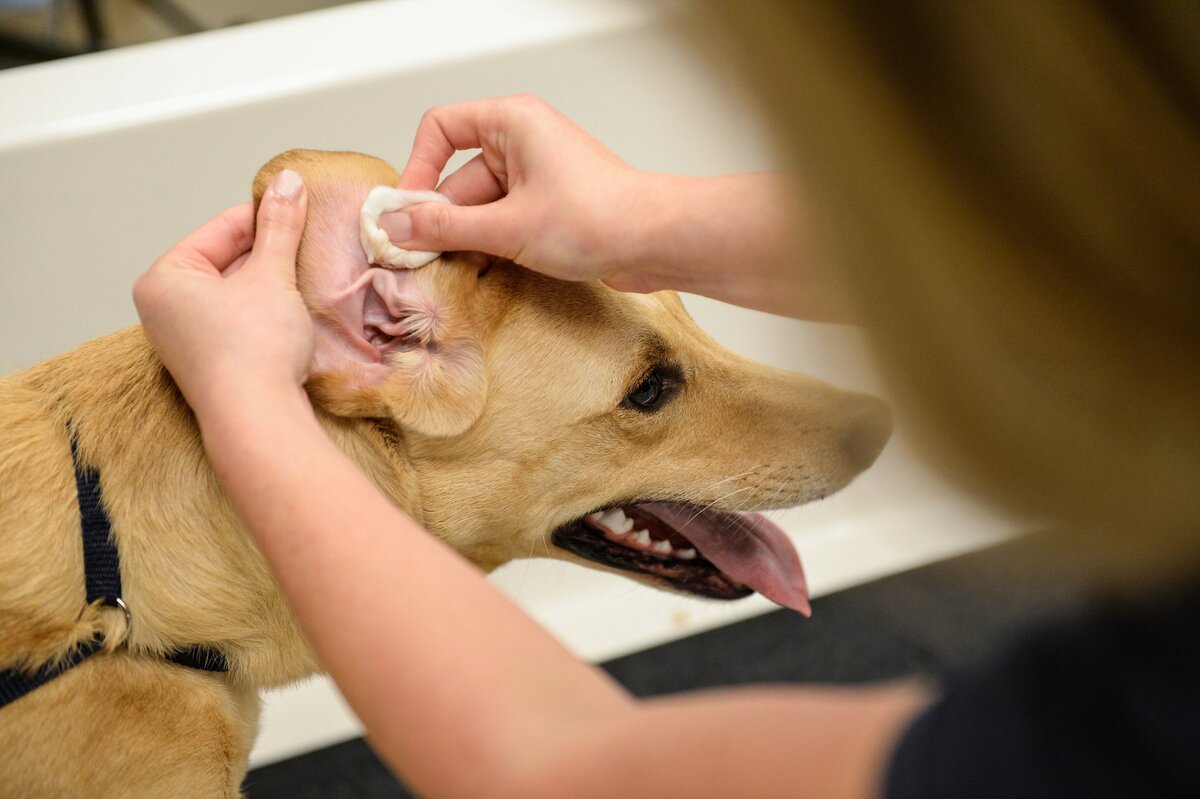Home>Health & Wellness>Common Health Issues>What To Do For Environmental Allergies In Dogs


Common Health Issues
What To Do For Environmental Allergies In Dogs
Published: January 27, 2024
Learn how to manage environmental allergies in dogs, one of the common health issues, with effective tips and treatments to keep your pet healthy and happy.
(Many of the links in this article redirect to a specific reviewed product. Your purchase of these products through affiliate links helps to generate commission for Pawsomeoldies.com, at no extra cost. Learn more)
Table of Contents
Understanding Environmental Allergies in Dogs
Environmental allergies in dogs, also known as atopic dermatitis, are hypersensitive reactions to common environmental substances. These allergens can be found both indoors and outdoors, and they often trigger allergic responses in sensitive dogs. Common environmental allergens include pollen, mold, dust mites, and certain grasses. When a dog with a predisposition to allergies comes into contact with these substances, their immune system overreacts, leading to various symptoms of allergic reactions.
The immune system of a dog with environmental allergies identifies harmless substances as potential threats, prompting the release of histamines and other chemicals. This immune response leads to inflammation and irritation, primarily affecting the skin. Dogs may experience itching, redness, and discomfort, often leading to excessive scratching, licking, and chewing of the affected areas.
It's important to note that environmental allergies in dogs are not contagious and are not caused by poor hygiene or neglect. Instead, they are often linked to genetic predispositions and environmental factors. Certain breeds, such as Golden Retrievers, Bulldogs, and Terriers, are more prone to developing environmental allergies. Additionally, factors like air pollution, climate, and seasonal changes can influence the prevalence and severity of environmental allergies in dogs.
Understanding the underlying mechanisms of environmental allergies in dogs is crucial for pet owners. By recognizing the triggers and symptoms of environmental allergies, dog owners can take proactive steps to manage and alleviate their pet's discomfort. Identifying the common triggers for environmental allergies is the first step toward providing relief and improving the quality of life for dogs affected by these allergies.
Read more: What To Do About A Dog With Wheat Allergies?
Identifying Common Triggers for Environmental Allergies
Environmental allergies in dogs can be triggered by a wide range of substances commonly found in their surroundings. Identifying these common triggers is essential for managing and mitigating the impact of environmental allergies on dogs. By recognizing the specific allergens that affect their pets, owners can take targeted measures to reduce exposure and alleviate allergic reactions.
-
Pollen: Pollen from trees, grasses, and weeds is a prevalent allergen for dogs, especially during the spring and fall seasons. When dogs come into contact with airborne pollen particles, they may experience allergic reactions, leading to symptoms such as itching, sneezing, and watery eyes.
-
Mold: Mold spores thrive in damp and humid environments, making them common indoor and outdoor allergens for dogs. Areas with poor ventilation, such as basements and bathrooms, can harbor mold, triggering allergic responses in sensitive dogs. Symptoms may include skin irritation, respiratory issues, and discomfort.
-
Dust Mites: These microscopic creatures are a common trigger for environmental allergies in dogs. Dust mites thrive in household dust, bedding, and upholstery, posing a constant threat to dogs with sensitivities. Symptoms of dust mite allergies may manifest as itching, skin redness, and ear infections.
-
Grasses and Weeds: Certain types of grasses and weeds can elicit allergic reactions in dogs, particularly when they come into direct contact with the skin. Dogs may develop skin rashes, hives, and intense itching after exposure to specific grass species or weed pollen.
-
Airborne Chemicals: Dogs can be sensitive to various airborne chemicals, including cleaning products, perfumes, and cigarette smoke. These substances can exacerbate environmental allergies, leading to respiratory distress, skin irritation, and overall discomfort for affected dogs.
-
Insect Bites: Insect bites, particularly from fleas and mosquitoes, can trigger allergic reactions in dogs. The saliva of these insects contains allergens that can cause intense itching, skin inflammation, and allergic dermatitis in dogs with hypersensitivities.
By understanding these common triggers for environmental allergies in dogs, pet owners can take proactive measures to minimize their pets' exposure to these allergens. This may involve implementing environmental modifications, such as regular cleaning, using air purifiers, and minimizing outdoor activities during peak pollen seasons. Additionally, seeking veterinary guidance for allergy testing and treatment can provide valuable insights into the specific allergens affecting a dog, enabling targeted management strategies for environmental allergies.
Symptoms of Environmental Allergies in Dogs
Environmental allergies in dogs can manifest in a variety of symptoms, often causing discomfort and distress for affected pets. Recognizing these symptoms is crucial for pet owners to promptly address their dog's allergic reactions and seek appropriate veterinary care. The following are common symptoms associated with environmental allergies in dogs:
-
Skin Irritation: One of the hallmark signs of environmental allergies in dogs is skin irritation. Affected dogs may experience intense itching, leading to excessive scratching, licking, and chewing of the affected areas. This can result in redness, inflammation, and the development of hot spots or raw, irritated skin patches.
-
Ear Infections: Dogs with environmental allergies are prone to developing ear infections, characterized by redness, odor, and discharge from the ears. Persistent scratching of the ears and head shaking may indicate discomfort and the presence of allergic dermatitis in the ear canal.
-
Respiratory Issues: Allergens such as pollen, mold, and dust mites can trigger respiratory distress in dogs with environmental allergies. Symptoms may include sneezing, coughing, wheezing, and nasal discharge. In severe cases, dogs may exhibit labored breathing and reduced tolerance for physical activity.
-
Gastrointestinal Upset: Some dogs with environmental allergies may experience gastrointestinal symptoms, such as vomiting and diarrhea. Allergic reactions can lead to digestive disturbances, causing discomfort and impacting the overall well-being of affected dogs.
-
Hair Loss and Skin Lesions: Chronic exposure to environmental allergens can result in hair loss and the development of skin lesions in dogs. Areas of the skin may become scaly, crusty, or thickened, indicating allergic dermatitis and ongoing inflammatory responses.
-
Paw Licking and Chewing: Dogs may exhibit excessive licking and chewing of their paws in response to environmental allergies. This behavior can lead to redness, swelling, and irritation of the paw pads, often accompanied by a yeasty odor resulting from secondary yeast infections.
-
Behavioral Changes: Environmental allergies can cause dogs to experience discomfort and irritability, leading to changes in behavior. Dogs may appear restless, agitated, or lethargic as a result of their allergic reactions.
It is important to note that the severity and combination of symptoms can vary among individual dogs. Additionally, environmental allergies can exacerbate pre-existing skin conditions, complicating the clinical presentation. Pet owners should closely monitor their dog's health and behavior, particularly during peak allergy seasons, and seek veterinary evaluation if allergic symptoms are observed.
Understanding the diverse array of symptoms associated with environmental allergies in dogs empowers pet owners to advocate for their pet's well-being and collaborate with veterinarians to implement targeted treatment and management strategies. By addressing these symptoms proactively, pet owners can enhance the quality of life for their dogs and minimize the impact of environmental allergies on their overall health.
Seeking Veterinary Diagnosis and Treatment Options
Seeking veterinary guidance is paramount when addressing environmental allergies in dogs. Veterinarians play a crucial role in diagnosing allergic conditions and formulating comprehensive treatment plans tailored to the specific needs of each dog. When a dog exhibits symptoms indicative of environmental allergies, pet owners should promptly seek professional veterinary care to accurately diagnose the underlying allergens and implement effective treatment strategies.
Veterinary Diagnosis:
-
Comprehensive Physical Examination: Veterinarians conduct thorough physical examinations to assess the dog's overall health and examine the skin, ears, and respiratory system for signs of allergic reactions. This evaluation helps in identifying specific areas of concern and potential allergic manifestations.
-
Allergy Testing: Allergy testing, including intradermal skin testing or blood tests, can be performed to identify the specific environmental allergens triggering allergic responses in dogs. These tests provide valuable insights into the allergens to which the dog is sensitized, enabling targeted management approaches.
-
Skin Biopsies: In cases where chronic skin lesions or persistent dermatitis are present, veterinarians may recommend skin biopsies to assess the underlying inflammatory processes and rule out other skin conditions that may mimic allergic dermatitis.
Veterinary Treatment Options:
-
Allergy Management Plans: Based on the diagnostic findings, veterinarians develop customized allergy management plans to address the specific triggers affecting the dog. These plans may include environmental modifications, allergen avoidance strategies, and targeted interventions to alleviate allergic symptoms.
-
Prescription Medications: Veterinarians may prescribe medications such as antihistamines, corticosteroids, or immune-modulating drugs to manage allergic reactions and reduce inflammation. These medications aim to provide relief from itching, skin irritation, and other allergic manifestations.
-
Immunotherapy: Allergen-specific immunotherapy, commonly known as allergy shots, may be recommended for dogs with environmental allergies. This treatment involves administering gradually increasing doses of the identified allergens to desensitize the dog's immune system and reduce allergic responses over time.
-
Topical Therapies: Veterinary dermatologists may prescribe medicated shampoos, sprays, or topical treatments to soothe irritated skin, manage secondary infections, and promote skin barrier health in dogs with environmental allergies.
-
Nutritional Support: Veterinarians may recommend specialized diets or nutritional supplements to support the skin health and immune function of dogs with environmental allergies. These dietary interventions can complement the overall management of allergic conditions.
By collaborating closely with veterinarians, pet owners can gain valuable insights into the diagnosis and treatment options available for environmental allergies in dogs. Veterinary expertise and personalized care play a pivotal role in addressing allergic conditions, improving the well-being of affected dogs, and empowering pet owners to proactively manage their pet's environmental allergies.
Managing Environmental Allergies at Home
Managing environmental allergies at home is a proactive and essential aspect of caring for dogs with allergic sensitivities. By implementing targeted measures and environmental modifications, pet owners can create a supportive and allergen-minimized living environment for their dogs, ultimately reducing the impact of environmental allergies on their pet's well-being.
Read more: What To Do For A Dog With Grass Allergies
Environmental Modifications:
- Regular Cleaning: Maintaining a clean living environment is crucial for managing environmental allergies in dogs. Regular vacuuming, dusting, and washing of pet bedding help minimize the accumulation of dust mites, pollen, and other allergens indoors.
- Air Purification: Using high-efficiency particulate air (HEPA) filters in the home can help remove airborne allergens, improving indoor air quality and reducing the dog's exposure to environmental triggers.
- Allergen-Free Zones: Designating specific areas in the home as allergen-free zones, such as the dog's sleeping and resting areas, can provide relief from allergen exposure and promote a comfortable environment for the dog.
Allergen Avoidance Strategies:
- Limiting Outdoor Exposure: During peak pollen seasons, minimizing outdoor activities and walks in areas with high pollen counts can help reduce the dog's contact with environmental allergens.
- Regular Grooming: Bathing the dog with hypoallergenic shampoos and wiping their paws and coat after outdoor excursions can help remove pollen and other allergens from their fur, reducing the likelihood of allergic reactions.
- Bedding and Upholstery Care: Using allergen-resistant bedding covers and regularly washing pet bedding and upholstery can mitigate the presence of dust mites and other indoor allergens.
Supportive Skin Care:
- Moisturizing Skin Barrier: Applying veterinarian-recommended moisturizers and skin barrier products can help maintain the skin's health and reduce susceptibility to allergic dermatitis.
- Supplemental Nutrition: Providing a balanced diet rich in essential fatty acids and skin-supporting nutrients can contribute to the overall skin health of dogs with environmental allergies.
Monitoring Allergic Symptoms:
- Observational Vigilance: Pet owners should closely monitor their dog for any signs of allergic reactions, including itching, redness, and changes in behavior, and promptly seek veterinary evaluation if symptoms persist or worsen.
- Record Keeping: Maintaining a log of allergic symptoms, potential triggers, and environmental changes can aid in identifying patterns and facilitating discussions with the veterinarian.
By proactively managing environmental allergies at home, pet owners can create a supportive and allergen-minimized environment for their dogs, contributing to the overall well-being and comfort of pets affected by environmental allergies. Collaborating with veterinarians and implementing targeted strategies empowers pet owners to take an active role in managing their dog's allergic sensitivities and promoting a high quality of life for their beloved companions.
Read more: What To Do For Dogs With Chicken Allergies
Preventing Environmental Allergies in Dogs
Preventing environmental allergies in dogs involves proactive measures aimed at minimizing the risk of allergic sensitivities and creating a supportive living environment that reduces exposure to common allergens. While genetic predispositions and breed susceptibilities play a significant role in the development of environmental allergies, implementing preventive strategies can contribute to the overall well-being of dogs and potentially reduce the likelihood of allergic reactions.
Environmental Allergen Awareness
Raising awareness about common environmental allergens and their potential impact on dogs is a fundamental step in prevention. Educating pet owners about the prevalent allergens, such as pollen, mold, dust mites, and certain grasses, enables them to recognize potential triggers and take proactive measures to minimize their pet's exposure.
Allergen-Minimized Living Spaces
Creating allergen-minimized living spaces for dogs involves implementing environmental modifications to reduce the presence of allergens indoors. This includes regular cleaning, the use of air purifiers with HEPA filters, and the establishment of allergen-free zones within the home. By minimizing the accumulation of dust mites, pollen, and other indoor allergens, pet owners can create a more supportive environment for their dogs.
Nutritional Support for Skin Health
Providing a balanced and nutritionally complete diet that supports skin health can contribute to the overall well-being of dogs and potentially reduce the risk of allergic dermatitis. Essential fatty acids, such as omega-3 and omega-6 fatty acids, play a crucial role in maintaining skin barrier function and may help mitigate the impact of environmental allergens on the skin.
Regular Grooming and Paw Care
Incorporating regular grooming practices and paw care can help reduce the likelihood of allergens accumulating on the dog's coat and skin. Bathing dogs with hypoallergenic shampoos, wiping their paws after outdoor activities, and maintaining proper coat hygiene can minimize the presence of environmental allergens, thereby reducing the risk of allergic reactions.
Seasonal Allergen Management
Being mindful of seasonal changes and the prevalence of specific allergens during different times of the year is essential for preventing environmental allergies in dogs. During peak pollen seasons, limiting outdoor activities and walks in areas with high pollen counts can help reduce the dog's exposure to airborne allergens.
Veterinary Guidance and Allergy Testing
Seeking veterinary guidance and considering allergy testing for dogs with a predisposition to environmental allergies can provide valuable insights into potential allergens affecting the pet. Identifying specific triggers enables pet owners to implement targeted preventive measures and environmental modifications tailored to their dog's sensitivities.
By incorporating these preventive strategies, pet owners can actively contribute to the well-being of their dogs and potentially reduce the risk of environmental allergies. Creating a supportive and allergen-minimized living environment, coupled with nutritional support and proactive management, empowers pet owners to take a proactive approach in preventing environmental allergies in their beloved canine companions.












